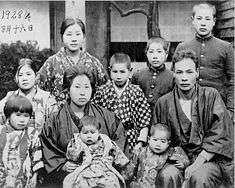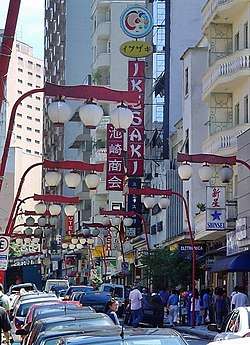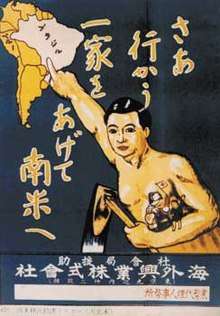Asian Brazilians
Asian Brazilians (Portuguese: brasileiros asiáticos) are Brazilian citizens of full or predominantly South Asian, East Asian and Southeast Asian ancestry or an Asian-born person permanently residing in Brazil. The vast majority of the Asian community in Brazil is made of immigrants from South Asia and East Asia, although there have also been smaller numbers of Southeast Asians, including a small number of Asians from the Caribbean, Mozambique and Kenya.
| Total population | |
|---|---|
| 2,300,000 1.2% of Brazilian population per 2010 Census[1][2] | |
| Regions with significant populations | |
| Mainly in São Paulo and Paraná | |
| Languages | |
| Predominantly Portuguese, Japanese, Chinese dialects, Macanese Patois, Korean, Vietnamese, Indonesian, Konkani, Gujarati, Marathi, Hindustani (Hindi-Urdu) and Tamil | |
| Religion | |
| Majority Christian:[3] 61.2% Roman Catholicism, 13.3% Protestantism, 12.5% Non-religious, 0.8% other Christian beliefs[4] Minority: Buddhism, Judaism, Shintoism and Shinto-derived Japanese new religions, Taoism, Hinduism, Islam, Sikhism, Jainism and Zoroastrianism[5] |

The 2011 estimate for Brazilian Roma is about 800,000, but they are not counted as Asian, although they have distant ancestors coming from South Asia. People of West Asian origin are also generally not counted as Asians. On the other hand in some states like Amapa, the Amerindian and East Asian population are put in one category.[6]
History
Recent research has suggested that Asians from the early Portuguese Eastern Empire, known as Luso-Asians first came to Brazil during the sixteenth century as seamen known as Lascars, or as servants, slaves and concubines accompanying the governors, merchants and clergy who has served in Portuguese Asia.[7] This first presence of Asians was limited to Northeast Brazil, especially Bahia, but others were brought as cultivators, textile workers and miners to Para and other parts of the Northeast. These Asians intermarried people of African and European ancestry and left a legacy in the food, early art and boat-making traditions of the Northeast.
The first substantial Asian immigration to Brazil were a small number of Chinese people (3,000) during the colonial period as coolie slaves. Later, significant immigration from Asia to Brazil would start in the late 19th century, when immigration from Lebanon and Syria became important. However in Brazil, most definitions of an Asian Brazilian usually do not refer to the community of West Asian origins such as Arabs, Jews, Turks, and Armenians.
The vast majority of Asian Brazilians have origins in Japan. The first Japanese immigrants arrived in Brazil in 1908. Until the 1950s, more than 250 thousand Japanese immigrated to Brazil. Currently, the Japanese-Brazilian population is estimated at 2.1 million people. It is the largest ethnic Japanese population outside Japan, followed closely by the Japanese community in the United States. Other East Asian groups are also significant in Brazil. The Korean Brazilian population is estimated to be 50,000, and the Chinese Brazilian population around 300,000. Over 70% of Asian Brazilians are concentrated in the state of São Paulo. There are significant populations in Paraná, Pará, Mato Grosso do Sul, and other parts of Brazil.
Japanese immigration to Brazil
In 1907, the Government of the State of São Paulo authorized Japan's Imperial Immigration Company to transfer, annually, a certain number of emigrants to Brazil. On June 18, 1908, the Japanese vessel Kasato Maru arrived at Santos' harbor with the first group of immigrants composed of 165 families, a total of 786 people. From the harbor they went to coffee farms, in the Mogiana region, State of São Paulo, to work as "colonists". There they started a new life in a foreign country with different climate, culture and language. Other quotas followed them and almost all of them went to live in coffee farms.

Between 1910 and 1914, approximately 14,200 immigrants arrived from Japan, who, after ending their labor contract in the coffee farms, went to the interior of the State, to the coast near the Santos Juquiá railway or to the suburbs of São Paulo, in order to get their independence. During the 1910s, they established several immigration centers in the region of the North West railway as well as alongside the banks of Ribeira River in Iguape. From 1925 to 1935, these centers spread statewide and became localities. By this time approximately 140,000 immigrants had arrived in Brazil.
The immigration influx was interrupted for 10 years because of World War II. In 1959 it started again but the quotas were smaller, especially those that arrived from 1961 on, date of the beginning of Japan's economic recuperation. Up to the present, approximately 260,000 immigrants have arrived in Brazil.
The biggest concentration of immigrants are:
- Japanese immigration
| State | Percentage |
|---|---|
| São Paulo | 73% |
| Paraná | 20% |
| Mato Grosso do Sul | 2.5% |
| Pará | 1.2% |
The others are living countrywide.
Their labor force is employed as follows: Agriculture (50%); Commerce (35%), Industry (15%). The industry has grown quickly in view of the establishment in Brazil of Japanese enterprises during the 60's. We believe that 800,000 people compose the Japanese community in Brazil, which is already in its 4th generation. The descendants of the immigrants perform all kind of activity within the cultural and economic sectors. In the past two decades we have had two State Ministers in the Brazilian Government.
Following their 80-year-old path immigrants and their descendants who have already close ties with Brazil take part and contribute with love and dedication to the construction of a better and developed country. This year, on June 18, they will celebrate with great rejoicing the beginning of the Japanese immigration into Brazil, since this day symbolizes a landmark of a history started 80 years ago.
Brazilians in Japan
The migration continued through the 1970s, despite the interruption of World War II, with a total of 250,000 people crossing the seas. Not only farmers, but also politicians, engineers and entrepreneurs among Japanese Brazilians appeared one after another. A reversal of that flow, and a swift increase of migrant workers in Japan, was triggered by the 1990 revisions to the immigration control law. At the request of the business community, second- and third-generation Japanese from Brazil were granted residence status without employment restrictions.
These Japanese-Brazilians are now 210,032 strong, exceeding the number of Japanese who originally moved to Brazil.[8] While more of them have permanent residency, how to educate their children has become a particularly acute problem. There is no shortage of cases in which such children stop attending school due to the language barrier and descend into delinquency. Even when they stay in school, many can form no tangible ambitions for the future. While it is natural to expect parents to take responsibility for their children's education, the success of such efforts depends upon adequate support in the classroom.
This experience has been portrayed in the works of Japanese-Brazilian film director Tizuka Yamasaki. Yamasaki visited Japan in the late 1990s to film a sequel to her first work (Gaijin - Os Caminhos da Liberdade aka Gaijin, a Brazilian Odyssey) with the objective of exploring why recent immigrants, despite being accepted into Japan under a so-called national policy, were treated as gaijin (aliens). She focused on the lifestyles of the Japanese-Brazilians, tracking the plights of their fourth-generation children, many of whom dropped out of school after being unable to adapt to Japan's educational system.
| Period | ||||||||||
|---|---|---|---|---|---|---|---|---|---|---|
| Ethnic group | 1904-1913 | 1914-1923 | 1924-1933 | 1945-1949 | 1950-1954 | 1955-1959 | ||||
| Japanese | 11,868 | 20,398 | 110,191 | 12 | 5,447 | 28,819 | ||||
See also
References
- Asian population climbed 173% in Brazil, according to 2010 Census (in Portuguese). O Globo. 2011. Retrieved 2011-05-30.
- The Japan Times Online
- Adital - Brasileiros no Japão Archived 2007-03-29 at the Wayback Machine
- (in Portuguese) Study Panorama of religions. Fundação Getúlio Vargas, 2003.
- Brazil
- Síntese de Indicadores Sociais 2007 (PDF) (in Portuguese). Amapá, Brazil: IBGE. 2007. ISBN 85-240-3919-1. Retrieved 2007-07-18.
- East in the West: Investigating the Asian presence and influence in Brazil from the 16th to 18th centuries. By Clifford Pereira, in Proceedings of the 2nd Asia-Pacific regional Conference on Underwater Cultural Heritage. Ed. Hans Van Tilberg, Sila Tripati, Veronica Walker, Brian Fahy and Jun Kimura. Honolulu, Hawai'i, USA. May 2014.
- 平成23年末現在における外国人登録者統計について 法務省, Japan: Ministry of Justice, February 2012, archived from the original on 2012-04-19, retrieved 2012-02-22
- "Estatísticas do Povoamento" [Population Statistics]. IBGE. Archived from the original on 9 August 2007.

